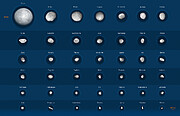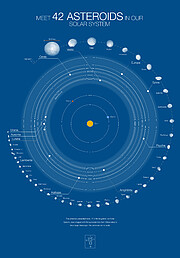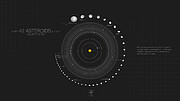Persbericht
Ontmoet de 42: ESO fotografeert enkele van de grootste planetoïden in ons zonnestelsel
12 oktober 2021

Met behulp van de Very Large Telescope (VLT) van de Europese Zuidelijke Sterrenwacht (ESO) in Chili hebben astronomen opnamen gemaakt van 42 van de grootste objecten in de planetoïdengordel tussen Mars en Jupiter. Nooit eerder is zo’n grote groep planetoïden zo scherp in beeld gebracht. De waarnemingen tonen een breed scala aan eigenaardige vormen, van bolvormig tot ‘hondenkluif’, en helpen astronomen om de oorsprong van de planetoïden in ons zonnestelsel te achterhalen.
De gedetailleerde opnamen van deze 42 objecten betekenen een sprong voorwaarts in het planetoïdenonderzoek. Deze is mogelijk gemaakt dankzij telescopen op de grond, en draagt bij aan het beantwoorden van de ultieme vraag naar leven, het heelal en de rest [1].
‘Tot nu toe waren slechts drie grote planetoïden in de hoofdgordel – Ceres, Vesta en Lutetia – gedetailleerd in beeld gebracht, omdat ze zijn bezocht door de ruimtemissies Dawn en Rosetta van respectievelijk NASA en ESA,’ aldus Pierre Vernazza van het Laboratoire d’Astrophysique de Marseille in Frankrijk, die de leiding had over het planetoïdenonderzoek waarvan de resultaten vandaag in Astronomy & Astrophysics zijn gepubliceerd. ‘Onze ESO-waarnemingen hebben scherpe beelden van een veel groter aantal opgeleverd: 42 in totaal.’
Het tot nog toe geringe aantal gedetailleerde waarnemingen van planetoïden betekende dat belangrijke kenmerken zoals hun driedimensionale vorm of dichtheid tot nu toe grotendeels onbekend waren gebleven. Tussen 2017 en 2019 hebben Vernazza en zijn team het plan opgevat om deze leemte opvullen door de belangrijkste objecten in de planetoïdengordel aan een grondig onderzoek te onderwerpen.
De meeste van de 42 objecten in hun steekproef zijn groter dan honderd kilometer. In het bijzonder heeft het team bijna alle planetoïden in de gordel met afmetingen groter dan tweehonderd kilometer in beeld gebracht (20 van de 23). De twee grootste objecten die het team heeft onderzocht zijn Ceres en Vesta, met diameters van ongeveer 940 en 520 kilometer. De twee kleinste planetoïden in de steekproef, Urania en Ausonia, zijn elk slechts ongeveer negentig kilometer groot.
Door de vormen van de objecten te reconstrueren, realiseerde het team zich dat de waargenomen planetoïden in grote lijnen in twee families kunnen worden ingedeeld. Sommige, zoals Hygiea en Ceres, zijn bijna volmaakt bolvormig terwijl andere een meer eigenaardige, ‘langgerekte’ vorm hebben, met als onbetwiste koningin de ‘hondenkluif’-planetoïde Kleopatra.
Door de vormen van de planetoïden te combineren met informatie over hun massa’s, ontdekte het team dat de dichtheid van de planetoïden over de hele linie sterk verschilt. De vier minst dichte onderzochte planetoïden, waaronder Lamberta en Sylvia, hebben een dichtheid van ongeveer 1,3 gram per kubieke centimeter – zo’n beetje de dichtheid van steenkool. Met respectievelijk 3,9 en 4,4 gram per kubieke centimeter – hoger dan de dichtheid van diamant (3,5 gram per kubieke centimeter) – hebben Psyche en Kalliope de hoogste dichtheden.
Deze grote verschillen in dichtheid wijzen erop dat de samenstelling van de planetoïden aanzienlijk varieert, wat astronomen belangrijke aanwijzingen geeft over hun oorsprong. ‘Onze waarnemingen onderbouwen het idee dat deze objecten sinds hun vorming een substantiële migratie hebben doorgemaakt. De enorme variatie in hun samenstelling kan, kort gezegd, alleen worden begrepen als de objecten in verschillende delen van het zonnestelsel zijn ontstaan,’ legt Josef Hanuš van de Karelsuniversiteit Praag, Tsjechië, een van de auteurs van de studie uit. De resultaten ondersteunen met name de theorie dat de planetoïden met de laagste dichtheid zich in het afgelegen gebied voorbij de baan van Neptunus hebben gevormd, en later naar hun huidige locatie zijn gemigreerd.
Deze bevindingen zijn te danken aan de gevoeligheid van het Spectro-Polarimetric High-contrast Exoplanet REsearch (SPHERE)-instrument dat aan ESO’s VLT is gekoppeld [2]. ‘Dankzij de verbeterde mogelijkheden van SPHERE en het feit dat er weinig bekend was over de vormen van de grootste planetoïden in de hoofdgordel, hebben we aanzienlijke vooruitgang kunnen boeken op dit gebied,’ zegt medeauteur Laurent Jorda, eveneens van het Laboratoire d’Astrophysique de Marseille.
Astronomen zullen nog meer planetoïden gedetailleerd in beeld kunnen brengen met ESO’s Extremely Large Telescope (ELT), die momenteel in Chili wordt gebouwd en later dit decennium in gebruik zal worden genomen. ‘ELT-waarnemingen van planetoïden in de hoofdgordel zullen ons in staat stellen om objecten te onderzoeken met diameters tot 35 à 80 kilometer, afhankelijk van hun locatie in de gordel, en kraters tot ongeveer 10 à 25 kilometer groot,’ zegt Vernazza. ‘Met een SPHERE-achtig instrument op de ELT zouden we zelfs een vergelijkbare steekproef kunnen nemen van objecten in de verre Kuipergordel. Dit betekent dat we de geologische geschiedenis van een veel grotere steekproef van kleine objecten vanaf de grond in kaart kunnen brengen.’
Noten
[1] In The Hitchhiker's Guide to the Galaxy (Het transgalactisch liftershandboek) van Douglas Adams, het getal 42 het antwoord op de ‘ultieme vraag naar het leven, het heelal en de rest’. Vandaag, 12 oktober 2021, is de 42ste verjaardag van de publicatie van het boek.
[2] Alle waarnemingen zijn uitgevoerd met de Zurich IMaging POLarimeter (ZIMPOL), een beeldvormend subsysteem van het SPHERE-instrument dat op zichtbare golflengten opereert.
Meer informatie
De resultaten van dit onderzoek zijn te vinden in een artikel dat in Astronomy & Astrophysics verschijnt (https://www.aanda.org/10.1051/0004-6361/202141781).
Het onderzoeksteam bestaat uit P. Vernazza (Aix Marseille Université, CNRS, CNES, Laboratoire d’Astrophysique de Marseille, Frankrijk [LAM]), M. Ferrais (LAM), L. Jorda (LAM), J. Hanuš (Institute of Astronomy, Faculty of Mathematics and Physics, Karelsuniversiteit Praag, Tsjechië [CU]), B. Carry (Université Côte d’Azur, Observatoire de la Côte d’Azur, CNRS, Laboratoire Lagrange, Frankrijk [OCA]), M. Marsset (Department of Earth, Atmospheric and Planetary Sciences, MIT, Cambridge, VS [MIT]), M. Brož (CU), R. Fetick (French Areospace Lab [ONERA] en LAM), M. Viikinkoski (Mathematics & Statistics, Tampere University, Finland [TU]), F. Marchis (LAM en SETI Institute, Carl Sagan Center, Mountain View, VS), F. Vachier (Institut de mécanique céleste et de calcul des éphémérides, Observatoire de Paris, PSL Research University, CNRS, Sorbonne Universités, UPMC University Paris 06 and Université de Lille, France [IMCCE]), A. Drouard (LAM), T. Fusco (French Areospace Lab [ONERA] en LAM), M. Birlan (IMCCE en Astronomical Institute of Romanian Academy, Boekarest, Romanië [AIRA]), E. Podlewska-Gaca (Faculty of Physics, Astronomical Observatory Institute, Adam Mickiewicz-Universiteit, Poznań, Polen [UAM]), N. Rambaux (IMCCE), M. Neveu (University of Maryland College Park, NASA Goddard Space Flight Center, VS [UMD]), P. Bartczak (UAM), G. Dudziński (UAM), E. Jehin (Space sciences, Technologies and Astrophysics Research Institute, Universiteit van Luik [STAR]), P. Beck (Institut de Planetologie et d’Astrophysique de Grenoble, UGA-CNRS, Frankrijk [OSUG]), J. Berthier (IMCCE), J. Castillo-Rogez (Jet Propulsion Laboratory, California Institute of Technology, Pasadena, VS [JPL]), F. Cipriani (European Space Agency, ESTEC - Scientific Support Office, Noordwijk [ESTEC] ), F. Colas (IMCCE), C. Dumas (Thirty Meter Telescope, Pasadena, VS [TMT]), J. Ďurech (CU), J. Grice (Laboratoire Atmosphères, Milieux et Observations Spatiales, CNRS en Université de Versailles Saint-Quentin-en-Yvelines, Guyancourt, Frankrijk [UVSQ] en School of Physical Sciences, The Open University, Milton Keynes, VK [OU]), M. Kaasalainen (TU), A. Kryszczynska (UAM), P. Lamy (Departamento de Fisica, Ingeniería de Sistemas y Teoría de la Señal, Universidad de Alicante, Alicante, Spanje), H. Le Coroller (LAM), A. Marciniak (UAM), T. Michalowski (UAM), P. Michel (OCA), T. Santana-Ros (Institut de Ciències del Cosmos, Universitat de Barcelona, Spanje en European Southern Observatory, Santiago, Chili), P. Tanga (OCA), A. Vigan (LAM), O. Witasse (ESTEC), B. Yang (European Southern Observatory, Santiago, Chili), P. Antonini (Observatoire des Hauts Pays, Bédoin, Frankrijk), M. Audejean (Observatoire de Chinon, Chinon, Frankrijk), P. Aurard (AMU, Observatoire de Haute Provence, Institut Pythéas, Saint-Michel l’Observatoire, Frankrijk [OHP]), R. Behrend (Geneva Observatory, Sauverny, Zwitserland en High Energy Physics and Astrophysics Laboratory, Cadi Ayyad University, Marrakech, Marokko [UCA]), Z. Benkhaldoun (UCA), J.M. Bosch (B74, Avinguda de Catalunya 34, 25354 Santa Maria de Montmagastrell (Tarrega), Spanje), A. Chapman (Cruz del Sur Observatory, San Justo city, Buenos Aires, Argentinië), L. Dalmon (OHP), S. Fauvaud (Observatoire du Bois de Bardon, Taponnat, Frankrijk en Association T60, Observatoire Midi-Pyrénées, Toulouse, Frankrijk), Hiroko Hamanowa (Hong Kong Space Museum, Tsimshatsui, Hong Kong, China [HKSM]), Hiromi Hamanowa (HKSM), J. His (OHP), A. Jones (I64, SL6 1XE, Maidenhead, VK), D-H. Kim (Korea Astronomy and Space Science Institute, Daejeon, Korea [KASI] en Chungbuk National University, Chungdae-ro, Seowon-gu, Cheongju-si, Chungcheongbuk-do, Korea), M-J. Kim (KASI), J. Krajewski (Faculty of Physics, Astronomical Observatory Institute, Adam Mickiewicz-Universiteit, Poznań, Polen), O. Labrevoir (OHP), A. Leroy (Observatoire OPERA, Saint Palais, Frankrijk [OPERA] en Uranoscope, Gretz-Armainvilliers, Frankrijk), F. Livet (Institut d’Astrophysique de Paris, Parijs, Frankrijk, UMR 7095 CNRS et Sorbonne Universités), D. Molina (Anunaki Observatory, Calle de los Llanos, Manzanares el Real, Spanje), R. Montaigut (Club d’Astronomie de Lyon Ampere, Vaulx-en-Velin, Frankrijk and OPERA), J. Oey (Kingsgrove, NSW, Australië), N. Payre (OHP), V. Reddy (Planetary Science Institute, Tucson, VS), P. Sabin (OHP), A.G. Sanchez (Rio Cofio Observatory, Robledo de Chavela, Spanje), en L. Socha (Cicha 43, 44-144 Nieborowice, Polen).
ESO is de belangrijkste intergouvernementele astronomische organisatie in Europa en verreweg de meest productieve sterrenwacht ter wereld. Zij wordt ondersteund door zestien lidstaten: België, Denemarken, Duitsland, Finland, Frankrijk, Ierland, Italië, Nederland, Oostenrijk, Polen, Portugal, Spanje, Tsjechië, het Verenigd Koninkrijk, Zweden en Zwitserland, en door gastland Chili, met Australië als strategische partner. ESO voert een ambitieus programma uit, gericht op het ontwerpen, bouwen en beheren van grote sterrenwachten die astronomen in staat stellen om belangrijke wetenschappelijke ontdekkingen te doen. Ook speelt ESO een leidende rol bij het bevorderen en organiseren van samenwerking op astronomisch gebied. ESO beheert drie waarnemingslocaties van wereldklasse in Chili: La Silla, Paranal en Chajnantor. Op Paranal staan ESO’s Very Large Telescope (VLT) en haar toonaangevende Very Large Telescope Interferometer, evenals twee surveytelescopen – VISTA, die in het infrarood werkt, en de op zichtbare golflengten opererende VLT Survey Telescope. Ook op Paranal zal ESO onderkomen bieden aan en het beheer voeren over de Cherenkov Telescope Array South, ’s werelds grootste en meest gevoelige observatorium van gammastraling. ESO speelt tevens een belangrijke partnerrol bij twee faciliteiten op Chajnantor, APEX en ALMA, het grootste astronomische project van dit moment. En op Cerro Armazones, nabij Paranal, bouwt ESO de 39-meter Extremely Large Telescope, de ELT, die ‘het grootste oog op de hemel’ ter wereld zal worden.
Links
- Onderzoeksartikel
- Foto’s van de VLT
- Kom meer te weten over ESO’s Extremely Large Telescope
- Voor journalisten: abonneer je op persberichten in je eigen taal
- Voor wetenschappers: heb je een verhaal? Promoot je onderzoek
Contact
Pierre Vernazza
Laboratoire d’Astrophysique de Marseille
Marseille, France
Tel: +33 4 91 05 59 11
E-mail: pierre.vernazza@lam.fr
Josef Hanuš
Charles University
Prague, Czechia
E-mail: josef.hanus@mff.cuni.cz
Laurent Jorda
Laboratoire d’Astrophysique de Marseille
Marseille, France
Tel: +33 4 91 05 69 06
E-mail: laurent.jorda@lam.fr
Bárbara Ferreira
ESO Media Manager
Garching bei München, Germany
Tel: +49 89 3200 6670
Mobiel: +49 151 241 664 00
E-mail: press@eso.org
Marieke Baan (Perscontact Nederland)
ESO Science Outreach Network
en NOVA Informatie Centrum
Tel: +31(0)20-5257480
E-mail: eson-netherlands@eso.org
Over dit bericht
| Persberichten nr.: | eso2114nl |
| Type: | Solar System : Interplanetary Body : Asteroid |
| Facility: | Very Large Telescope |
| Instruments: | SPHERE |
| Science data: | 2021A&A...654A..56V |
Our use of Cookies
We use cookies that are essential for accessing our websites and using our services. We also use cookies to analyse, measure and improve our websites’ performance, to enable content sharing via social media and to display media content hosted on third-party platforms.
ESO Cookies Policy
The European Organisation for Astronomical Research in the Southern Hemisphere (ESO) is the pre-eminent intergovernmental science and technology organisation in astronomy. It carries out an ambitious programme focused on the design, construction and operation of powerful ground-based observing facilities for astronomy.
This Cookies Policy is intended to provide clarity by outlining the cookies used on the ESO public websites, their functions, the options you have for controlling them, and the ways you can contact us for additional details.
What are cookies?
Cookies are small pieces of data stored on your device by websites you visit. They serve various purposes, such as remembering login credentials and preferences and enhance your browsing experience.
Categories of cookies we use
Essential cookies (always active): These cookies are strictly necessary for the proper functioning of our website. Without these cookies, the website cannot operate correctly, and certain services, such as logging in or accessing secure areas, may not be available; because they are essential for the website’s operation, they cannot be disabled.
Functional Cookies: These cookies enhance your browsing experience by enabling additional features and personalization, such as remembering your preferences and settings. While not strictly necessary for the website to function, they improve usability and convenience; these cookies are only placed if you provide your consent.
Analytics cookies: These cookies collect information about how visitors interact with our website, such as which pages are visited most often and how users navigate the site. This data helps us improve website performance, optimize content, and enhance the user experience; these cookies are only placed if you provide your consent. We use the following analytics cookies.
Matomo Cookies:
This website uses Matomo (formerly Piwik), an open source software which enables the statistical analysis of website visits. Matomo uses cookies (text files) which are saved on your computer and which allow us to analyze how you use our website. The website user information generated by the cookies will only be saved on the servers of our IT Department. We use this information to analyze www.eso.org visits and to prepare reports on website activities. These data will not be disclosed to third parties.
On behalf of ESO, Matomo will use this information for the purpose of evaluating your use of the website, compiling reports on website activity and providing other services relating to website activity and internet usage.
Matomo cookies settings:
Additional Third-party cookies on ESO websites: some of our pages display content from external providers, e.g. YouTube.
Such third-party services are outside of ESO control and may, at any time, change their terms of service, use of cookies, etc.
YouTube: Some videos on the ESO website are embedded from ESO’s official YouTube channel. We have enabled YouTube’s privacy-enhanced mode, meaning that no cookies are set unless the user actively clicks on the video to play it. Additionally, in this mode, YouTube does not store any personally identifiable cookie data for embedded video playbacks. For more details, please refer to YouTube’s embedding videos information page.
Cookies can also be classified based on the following elements.
Regarding the domain, there are:
- First-party cookies, set by the website you are currently visiting. They are stored by the same domain that you are browsing and are used to enhance your experience on that site;
- Third-party cookies, set by a domain other than the one you are currently visiting.
As for their duration, cookies can be:
- Browser-session cookies, which are deleted when the user closes the browser;
- Stored cookies, which stay on the user's device for a predetermined period of time.
How to manage cookies
Cookie settings: You can modify your cookie choices for the ESO webpages at any time by clicking on the link Cookie settings at the bottom of any page.
In your browser: If you wish to delete cookies or instruct your browser to delete or block cookies by default, please visit the help pages of your browser:
Please be aware that if you delete or decline cookies, certain functionalities of our website may be not be available and your browsing experience may be affected.
You can set most browsers to prevent any cookies being placed on your device, but you may then have to manually adjust some preferences every time you visit a site/page. And some services and functionalities may not work properly at all (e.g. profile logging-in, shop check out).
Updates to the ESO Cookies Policy
The ESO Cookies Policy may be subject to future updates, which will be made available on this page.
Additional information
For any queries related to cookies, please contact: pdprATesoDOTorg.
As ESO public webpages are managed by our Department of Communication, your questions will be dealt with the support of the said Department.









